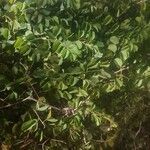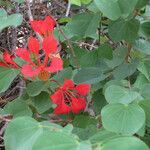Shrub, sometimes semiscandent but without tendrils, young branches ± densely brown puberulous. Leaves: stipules linear, 1-3 mm long; petiole slender, puberulous, 1-1.5 cm; lamina suborbicular, usually broader than long, up to 5 cm diam., 7-nerved; bifid 1/5-1/4 with broad sinus; tip of lobes rounded, base broadly to shallowly cor-date; upper surface glabrous, lower sparsely puberulous and with a marginal zone of yellow scales. Inflorescences lateral, short, few-flowered racemes, axis rusty puberulous; pedicels puberulous, c. 5 mm long; bracts subulate, 2 mm; bracteoles minute, setaceous, inserted at the base of hypanthium. Buds spindle-shaped, acute, 2-2.5 cm; hypanthium 2-3 cm long, narrow, infundibuliform, densely brown puberulous, finely striate. Calyx brown puberulous, splitting spathaceous, finally reflexed, c. 2 cm long. Petals spathulate, glabrous, 3-3.5 cm long including the 1.5-2 cm long claw, pinkish red to brick-red. Stamens 3, stout, fleshy, nearly as long as petals, glabrous; anthers ellipsoid-oblong, early caducous; staminodes 7, capillary, few mm long. Ovary 1 cm, rusty puberulous, stipitate; stipe c. 1 cm long, hairy as ovary; style c. 5 mm, glabrous towards the stigma; stigma inconspicuous. Pods thick-valved, 5-7 by 1.5 cm, glabrous, stipitate; stipe c. 1 cm long. Seeds 3-5, glossy, brown, oblong to obovate, c. 8 mm across.
Spreading shrub up to 4 m high, occasionally scandent, sometimes forming fairly large thickets; young branchlets ± densely brown-pubescent or-puberulous. Leaves: petiole 0.8-1.5 cm long; blade often wider than long, (1.5) 2.5-5 cm long, 3-7 cm wide, bilobed apically for about one-quarter of the length of the leaf, appressed-puberulous on lower surface; lobes obliquely obovate to ovate. Stipules 1.5-3 mm long. Inflorescence up to 10-flowered, terminal, axillary or leaf-opposed. Flower-buds: upper part (i.e. sepals) linear to linear-lanceolate in outline, 1-3.4 cm long before anthesis; hypanthium 1.2-3 cm long, ± densely brown-puberulous, finely longitudinally sulcate. Petals pinkish-red to brick-red or sometimes ± scarlet, 3-4 cm long, lamina abruptly widened above from a conspicuous basal claw which is almost as long as the lamina, glabrous above, the midrib pubescent outside and with small glands or scales. Stamens: 3 fertile, the filaments 2.5-3.5 cm long; staminodes 7, free, red, 3-6 mm long. Style 4-7 mm long. Pod linear-oblong to oblanceolate-oblong, 5-14 cm long, 2-3 cm wide, on a woody stipe 2-3 cm long, dehiscent, woody, puberulous when young but sometimes becoming glabrescent with age. Seeds chestnut-brown, irregularly oblong to obovate, 1-1.6 cm long, 0.6-1 cm wide.
Shrub or scandent climber, 1-8 m high. Branchlets brown pubescent. Leaves alternate, petioled, wider than long; lamina bilobed apically for ± 1/4; lobes obliquely obovate to ovate. Inflorescences terminal or axillary, up to 10-flowered raceme. Flowers showy. Calyx: sepals 5, spathaceous. Petals 5, brick-red, lamina abruptly widened above from a basal claw. Hypanthium linear-lanceolate, 12-30 mm long, densely brown-puberulous. Stamens 3 fertile, 5-7 staminodes, red. Gynoecium 1-carpelled, with gynophore, linear-oblong, many ovules; style 4-7 mm, glabrous. Flowering time Oct.-Mar. Pod ± linear-oblong, woody, dehiscent, puberulous when young. Seeds chestnut-brown, ± oblong, 16 x 10 mm.
Leaves: petiole 0.5–1.5(2.3) cm; lamina 2–4.5(6.5) cm from base of midrib to tip of lobes, lobed for less than one third of its length and sometimes appearing only emarginate at the apex, the angle between the lobes commonly 90° or more but occasionally acute, cordate to truncate at the base, the lobes rounded or broadly obtusely pointed, glabrous above, the lower surface regularly covered with minute, usually appressed, greyish hairs and also with occasional scattered, much shorter, orange medifixed trichomes.
Petals bright red (variously described as scarlet, crimson, brick red, nasturtium, geranium red, salmon, or bluish red), 2.6–4.6 cm long, the limb suborbicular, cuneate to cordate at the base, and equalled or exceeded in length by the conspicuous claw, the undersurface furnished with orange trichomes like those on the leaf undersurface.
Spreading shrub, up to 4 m high. Leaves 2-lobed. Fertile stamens 3-6. Petals with conspicuous basal claw, almost as long as lamina. Pods linear-oblong, 50-140 x 20-30 mm. Flowers pinkish red to brick-red.
Pods dark reddish brown, 8–13 × 1.8–2.8 cm, ± linear-oblong, expanded along the upper margin into a flange up to 1 cm across, puberulent to pubescent when young but glabrescent later.
Inflorescences 2–10-flowered; axes densely puberulous to pubescent with appressed brown hairs; pedicels 2–5 mm, merging into the hypanthium.
Hypanthium 1.7–3.2 cm, brown-puberulous to pubescent, obscurely to conspicuously longitudinally ribbed.
Stamens 3, staminodes 7, filiform, up to 6 mm long.
Ovary densely appressed-pubescent; stigma clavate.
Shrub 1–4 m high or scrambling up to 5 m or more.
Calyx 1.9–2.8 cm, brown puberulous to pubescent.
Seeds dark reddish brown, c.11 × 8.5 mm.
Young branches puberulous.









